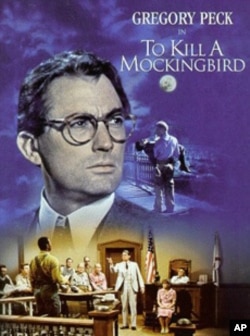It's been 50 years since the classic novel, "To Kill a Mockingbird," was published.
Set in a fictional town in the American South in the 1930s, Mockingbird is one of the best-loved books in the United States. Its story of a failed quest for racial justice still resonates in the town where the novel was written.
When Harper Lee published "To Kill a Mockingbird," on July 11, 1960, the civil rights movement was gaining strength and forcing change in U.S. society. However, in the author 's Southern hometown, laws and customs still kept black and white people separated in almost every facet of life.
'It's a sin to kill a mockingbird'
Set in a fictional Alabama town, Mockingbird is the story of a young girl, named Scout, and her father's legal defense of a black man wrongfully accused of raping a white woman.
The book's title comes from Atticus Finch's warning to his daughter, Scout, and her friend about using an air-rifle.
"Shoot all the bluejays you want, if you can hit 'em, but remember it's a sin to kill a mockingbird."
Their neighbor explains, "Mockingbirds don't do one thing but make music for us to enjoy. They don't eat up people's gardens, don't nest in corncribs, they don't do one thing but sing their hearts out for us. That's why it's a sin to kill a mockingbird."
And that's the moral of the story, says Melinda Byrd-Murphy. "Be kind to one another. Show human empathy and sympathy." Byrd-Murphy is the head of the Alabama Center for Literary Arts, and a native of Monroeville, Harper Lee's hometown. She's read "To Kill a Mockingbird" four times.
"I think if anything, this book talks about humanity, and the universality of humans and how there's goodness in people and you just have to get to know your neighbors."
That message has resonated with readers and critics over the years. Mockingbird is required reading in English classes around the world, and it's been called a book every adult should read before they die. Winner of the Pulitzer Prize, Mockingbird has sold over 40 million copies, has been translated into more than 40 languages and was made into an Academy Award-winning movie.
A changed town
For the people of Monroeville, Alabama, the story of "To Kill a Mockingbird" is a personal one.
Although the author calls the town where the story takes place, "Maycomb," Lee based the characters on real people she knew growing up.
But Monroeville has changed a lot since Harper Lee was a child. A number of African-Americans now serve in local government. The courthouse that played such a powerful role in the story has been turned into a Mockingbird Museum. Lee's childhood home has been replaced by a small shop and a fast food restaurant called Mel's Dairy Dream.
Resident Keith Cannon's son just read the book in school. "He's just getting into asking a lot of questions, 'Did that really happen here?' Well, the lady who wrote it is from here, so you don't really know if it's all fiction or based on something in her past," says Cannon. "But, he's really excited about that."
But folks in Monroeville were not very excited about the book when it was first published in 1960.
George Thomas Jones was there at that time. He's used to being interviewed about his long-time friend, who he calls by her first name, Nelle.
"The most asked question is what was the effect on the town of the book when it came out. Of course, the answer is there was no effect. People said, 'So Nelle's written a book 'bout folks in town.' They had no idea it was going to boomerang like it did."
But, Jones says, they paid attention a year later, when Gregory Peck, the lead actor in the movie version of the book, visited Monroeville for research before filming began.
"He was just real down to earth, walked around town by himself talking to people," he recalls. "'Course all the women dressed up in their best clothes and all their jewelry and their make-up, as if he was going to pay any attention."
Peck used that research in his Oscar-winning portrayal of Atticus Finch. In the lawyer's closing argument, he appeals to the jury to see past the racially motivated lies told to convict his client.
Despite a passionate defense, the all-white jury finds the defendant guilty and sentences him to death.
A good read
In addition to the moral lessons in the book — racial justice, respect, tolerance and love — Melinda Byrd-Murphy, at the Alabama Center for Literary Arts, says Lee's writing is what keeps "To Kill a Mockingbird" popular.
"It is just a great book to read and I think that that's why people will continue to read it."
In Monroeville and across the United States this year, people are celebrating the 50th anniversary of "To Kill a Mockingbird" with readings from the book, discussions, movie screenings, music and art inspired by the story as well as southern-style barbecues.













